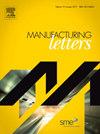飞秒激光连接人造卫星和不锈钢
IF 1.9
Q3 ENGINEERING, MANUFACTURING
引用次数: 0
摘要
这项研究探讨了利用各种激光焊接方法将以高性能著称的钴铬合金 Stellite 6 与不锈钢熔合的实用性。所面临的主要挑战是异种材料的连接,这就带来了熔点不同和热膨胀系数不同等障碍。目的是在人造卫星和不锈钢之间实现冶金结合,并保持理想的性能。研究采用了连续波和飞秒激光焊接技术,并对焊接接头进行了严格分析,以评估其对粘接性能的影响。最初的拉伸测试确定了材料的固有机械特性,结果表明,虽然 Stellite 的极限拉伸强度较低,但与不锈钢相比,它能以更大的伸长率进行补偿。事实证明,使用连续波激光焊接能够形成粘接;但是,由于涉及热加工,Stellite 组件的抗拉强度也大幅下降。相比之下,飞秒激光焊接是一种更有效的方法,它提高了接头的整体强度和延展性。这种改进归功于飞秒激光对热暴露的精确控制,它将热量限制在预定的焊接区域,从而保护了邻近材料免受损坏。扫描电子显微镜还提供了更多信息,显示飞秒激光焊接的样品具有更佳的晶间断裂--这通常与韧性破坏模式有关。飞秒激光焊接方法的接合效率高达 53.7%,反映了 Stellite 金属丝与生俱来的屈服强度。这一结果表明,这种焊接接头具有实际应用所需的坚固性,从而凸显了飞秒激光焊接在需要将斯特莱特合金与不锈钢连接的应用中的潜力。本文章由计算机程序翻译,如有差异,请以英文原文为准。
Femtosecond laser joining of Stellite and stainless steel
This research explores the practicality of fusing Stellite 6, a cobalt-chromium alloy known for its high performance, with stainless steel, utilizing various laser welding approaches. The primary challenge addressed is the joining of dissimilar materials, which presents obstacles such as divergent melting points and disparate coefficients of thermal expansion. The aim is to achieve a metallurgical bond between Stellite and stainless steel that retains desirable properties. The study employs both continuous wave and femtosecond laser welding techniques, subjecting the resultant joints to rigorous analysis to assess their impact on the properties of the bond. Initial tensile testing delineated the intrinsic mechanical characteristics of the materials, revealing that while Stellite exhibits a lower ultimate tensile strength, it compensates with greater elongation compared to stainless steel. The use of continuous wave laser welding proved to be capable of creating the bond; however, it also precipitated a considerable decline in the tensile strength of the Stellite component as a result of the thermal processing involved. In contrast, femtosecond laser welding emerged as a more effective method, enhancing the joint’s overall strength and ductility. This improvement is attributed to the femtosecond laser’s precise control over thermal exposure, which confines the heat to the intended weld zone, thereby safeguarding the adjacent material from damage. Further insights were gleaned from Scanning Electron Microscopy, which showed a preferable intergranular fracture in samples welded with the femtosecond laser—a feature typically associated with ductile failure modes. The femtosecond laser welding approach culminated in a joint efficiency of 53.7%, mirroring the innate yield strength of the Stellite wire. This outcome suggests that such welded joints possess the requisite robustness for practical deployment, thus underscoring the potential of femtosecond laser welding in applications requiring the joining of Stellite to stainless steel.
求助全文
通过发布文献求助,成功后即可免费获取论文全文。
去求助
来源期刊

Manufacturing Letters
Engineering-Industrial and Manufacturing Engineering
CiteScore
4.20
自引率
5.10%
发文量
192
审稿时长
60 days
 求助内容:
求助内容: 应助结果提醒方式:
应助结果提醒方式:


